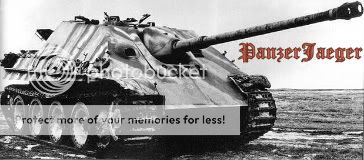As good as the late war German armour was - and it was very good - those ratios have more to do with skill and experience than anything else. German tankers were simply amazing, in a class of their own.Originally Posted by Husar
The reason the ratios aren't 20:1 is that the USSR actually had some very good tanks. The T34/76 and T34/85 were extremely solid tanks. They came into their own at a time when the Pz.IV was the main German medium tank. I've read a lot about armoured combat in the East and there is a consant refrain of German commanders in Pz.IVs, Pz. IIIs, StuGs, etc outmanuevering their Soviet rivals, only to have their repeated shots bounce right off. Had the Soviets instead produced large quantities of a Sherman copy - things would have been dire indeed.
Tank warfare in the East is often characterized as a David and Goliath struggle, with the lowly T-34 fighting the mammoth Tiger. While this was true in some circumstances, with Tigers pulling off amazing victories against far greater forces, most of the Panzer Korps was fighting in inferior tanks - yet still managed the success that they did.
When it comes to the big cats, such as the Tiger, Panther, King Tiger, and some of the big tank destroyers, their biggest enemies were themselves. In proper working order, they were amazingly effective against far greater forces.
Unfortunately for the Germans, late war pressures meant an increase in production faults and logistical issues. As you mentioned, that meant that these beasts succumbed to mechanical breakdowns or a lack of logistical support more often than enemy fire. Also, the growing Soviet air presence became increasingly deadly to German AFVs of all types. (It was never as big of an issue as it was on the Western Front, where German tanks could barely manuever at all.)
It is also imporant to mention that tank versus tank combat was not as typical as portrayed. While plenty of it went on, assaults against enemy infantry and fortified positions were far more common experiences. Commanders typically wanted to preserve their tanks for armoured thrusts, and prefered to engage enemy armour with tank destroyers, AT guns, or other methods.
The Russian military became better as the war progressed. It never quite reached the level of German military thinking, but far surpassed the other allies.Oh and since someone said the soviet army was a very good force since it defeated the german army, well, when one army outnumbers the other 20:1 then even a 10:1 kill ration on the side of the outnumbered army isn't going to help a lot and one has to keep in mind that geographically the soviet union outnumbered germany quite a bit from the start, plus they got a whole lot of equipment and money from the united states
The sheer weight of Russian manpower practically eliminated the importance of tactics and manuever in the East. In the begining, the Germans encircled and destroyed enormous armies. Even after Hitler's stupidity at Stalingrad and Kursk, Manstein and other German commanders were able to pull off some amazing tactical victories against huge odds, such as Kharkov.
However, a tactical victory that would have been a huge blow to an equally sized military meant very little to the Russian command. They simply pulled back, wrote another hundred thousand soldiers off the books, and pressed on with their war of attrition.
It should be noted, though, that the Russian military was thouroughly exhausted by the end of the war.
Many people blame Italian incompetence for the Axis defeat.I don't like Italy being on place 2 as they were probably one of the biggest failures in the war or can anyone tell me where they achieved anything without daddy germany coming to help them out? *waits for Tribesman to come and crush his fantasies about italy being bad*







 Reply With Quote
Reply With Quote



































Bookmarks